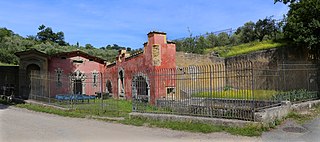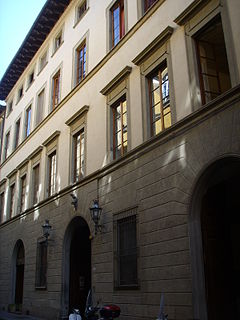 W
WThe Giardino Bardini is an Italian Renaissance garden of the Villa Bardini in the hilly part of Oltrarno, offering fine views of Florence, Italy. Opened only recently to the public, it is one of Florence's well kept secrets.
 W
WThe Boboli Gardens is a historical park of the city of Florence that was opened to the public in 1766. Originally designed for the Medici, it represents one of the first and most important examples of the Italian garden, which later served as inspiration for many European courts. The large green area is a real open-air museum with statues of various styles and periods, ancient and Renaissance that are distributed throughout the garden. It also has large fountains and caves, among them the splendid Buontalenti grotto built by the artist, architect, and sculptor Bernardo Buontalenti between 1536 and 1608.
 W
WThe Villa di Castello, near the hills bordering Florence, Tuscany, central Italy, was the country residence of Cosimo I de' Medici, Grand Duke of Tuscany (1519-1574). The gardens, filled with fountains, statuary, and a grotto, became famous throughout Europe. The villa also housed some of the great art treasures of Florence, including Sandro Botticelli's Renaissance masterpieces The Birth of Venus and Primavera. The gardens of the Villa had a profound influence upon the design of the Italian Renaissance garden and the later French formal garden.
 W
WThe Fonte della Fata Morgana, locally also called '"Casina delle Fate", at Grassina, is a small garden building located not far from Florence, Italy, in the comune of Bagno a Ripoli. It was built in 1573–74 as a garden feature in the extensive grounds of the Villa il Riposo of Bernardo Vecchietti on the slope of the hill called Fattucchia.
 W
WThe Palazzo Frescobaldi is a Renaissance-style palace located in the Borgo Santo Spirito of central Florence, region of Tuscany, Italy. It located on via Santo Spirito 11-13. The garden abuts the rear of the Basilica di Santo Spirito.
 W
WThe Giardino Botanico Tropicale dell'Istituto Agronomico per l'Oltremare is a botanical garden specializing in tropical plants. It is located at via Antonio Cocchi 4, Florence, Tuscany, Italy, and open without charge on Thursday mornings and by appointment.
 W
WGiardino dell'Iris is a botanical garden specializing in the cultivation of iris flowers, symbol of Florence since 1251. It is located on the corner of Viale dei Colli and Piazzale Michelangelo in Florence, Italy, and open daily without charge from May 2–20 every year.
 W
WGiardino delle rose is a garden park in the Oltrarno district of Florence, in Tuscany, Italy. It is located below the Piazzale Michelangelo and offers a commanding view of the city.
 W
WPalazzo Mozzi or Palazzo de' Mozzi is an early Renaissance palace, located at the end of the Piazza de' Mozzi that emerges from Ponte alle Grazie and leads straight to the palace where via San Niccolò becomes via de' Bardi in the Quartiere of Santo Spirito in the Oltrarno section of Florence, region of Tuscany, Italy. The 13th-century palace housed the gallery of the highly successful antiquarian Stefano Bardini, of which the remnants were left to the commune, where they assembled the Museo Bardini or Mozzi Bardini, displaying Florentine art and artifacts up to the early Renaissance. The gardens elaborated against the hillside behind the palace were added mainly by Bardini.
 W
WThe Orto Botanico di Firenze, also known as the Giardino dei Semplici, the "Garden of simples", is a botanical garden maintained by the University of Florence. It is located at Via Micheli, 3, Florence, Italy, and open weekday mornings.
 W
WThe Parco delle Cascine (Cascine Park) is a monumental and historical park in the city of Florence. The park covers an area of 160 hectares. It has the shape of a long and narrow stripe, on the north bank of the Arno river. It extends from the centre of Florence until the point where the Mugnone flows into the Arno.
 W
WVilla Agape, previously named Villa Arrighetti, is a villa in Tuscany, Italy, situated in Florence on the hill of Arcetri, close to Piazzale Michelangelo. The original house was built in 1472, but was rebuilt in its present form by Giulio de Filippo Arrighetti in 1602. Arrighetti was friends with the scientist Galileo, who retired to Arcetri, effectively under house arrest after the condemnation of his theories. A plaque on the wall commemorates their friendship.
 W
WThe Palazzo Vivarelli Colonna is a palace located at via Ghibellina #30, corner with angolo via delle Conce, in central Florence in the region of Tuscany, Italy.